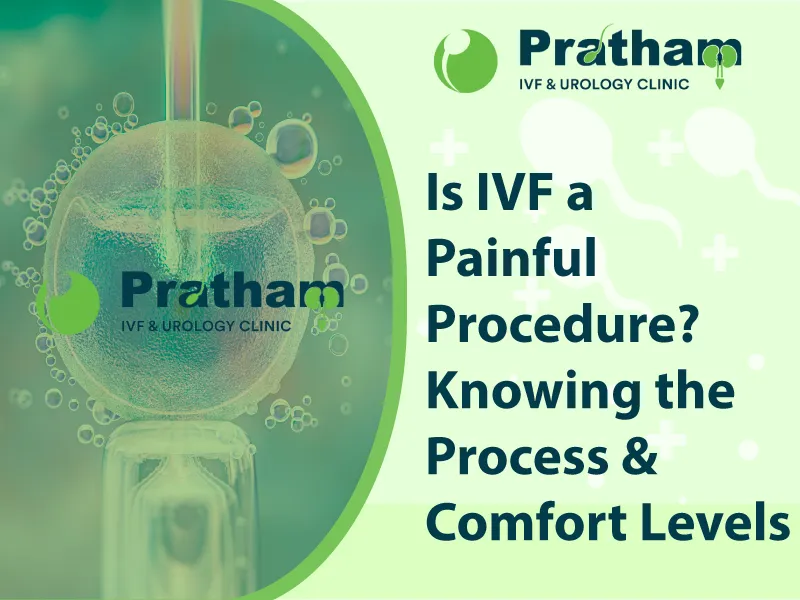
In vitro fertilization (IVF) is a popular fertility treatment that is helping many people and couples realize their dream of becoming parents. One common concern many people have when considering IVF is whether it is painful. While the process involves several steps, most of the discomfort experienced is minimal and manageable. IVF includes ovarian stimulation, egg retrieval and embryo transfer, which may cause some temporary discomfort or mild cramping. However, most procedures are done under sedation or with local anesthesia to minimize pain. Understanding each stage of the IVF procedure can help alleviate anxiety while making the experience less stressful. It's also essential to communicate openly with your healthcare provider about pain management options. Choosing the right IVF center ensures that you receive personalized care and support throughout the process, making your IVF journey smoother and more comfortable.
What is IVF? An Overview
IVF (In vitro fertilization) is a medical process in which eggs are fertilized by sperm outside the body in a lab. The resulting embryos are then transferred into the woman's uterus with the aim of achieving pregnancy. IVF is a groundbreaking treatment that helps couples and individuals facing infertility issues, including blocked fallopian tubes, male infertility, ovulation disorders, and unexplained infertility. IVF is also widely used for same-sex couples or individuals who wish to have biological children with the help of egg, sperm, or embryo donors.
While IVF has helped millions of people build families, it comes with several steps and medical interventions, leading some individuals to question whether the process is painful. It’s important to understand that pain tolerance varies, and most discomfort experienced during IVF is manageable with proper support and guidance.
What to Expect After the IVF Process
The IVF process involves multiple stages, each with its own set of procedures that may cause some discomfort. It’s crucial to understand each step and the potential discomfort or pain associated with it.
- Step 1: Initial Consultation and Testing
The initial stage in the IVF process is an appointment with a fertility doctor. During this visit, your medical history will be reviewed, and several tests will be performed to evaluate your reproductive health. Blood testing, ultrasound assessments, and the analysis of sperm are all common tests for male partners. This stage usually involves no pain or discomfort.
- Step 2: Ovarian Stimulation
Ovarian stimulation is one of the first active steps of the IVF therapy procedure. To produce multiple eggs, the woman undergoes hormone injections for approximately 8–14 days. These hormones stimulate the ovaries to produce several mature eggs for fertilization. While the hormone injections themselves are typically painless, some women may experience mild discomfort such as bloating, mood swings, and slight abdominal cramping due to the increased ovarian size.
Pain Level: Minimal to moderate discomfort, generally manageable. - Step 3: Monitoring Ovarian Response
Throughout the ovarian stimulation phase, regular blood tests and ultrasounds are performed to track the ovaries' response and confirm that the eggs are developing properly. The process itself is non-invasive, though frequent visits to the clinic may cause some inconvenience.
Pain Level: Mostly minimal discomfort due to frequent blood draws and ultrasounds. - Step 4: Egg Retrieval (Aspiration)
Egg retrieval is the most intrusive part of the IVF procedure. It is performed under sedation or light anesthesia, so you should not feel pain during the procedure. A needle is used to retrieve fully developed eggs by passing it through the vaginal wall and into the ovaries. While you will be sedated, some women report feeling bloated, crampy, or experiencing mild pelvic discomfort post-procedure. The feeling of discomfort or pain normally subsides within several hours to a days.
Pain Level: Mild to moderate discomfort post-procedure; minimal during the procedure due to sedation. - Step 5: Sperm Collection
On the day of egg retrieval, sperm is gathered from the male partner or a sperm donor. This is a non-invasive process, typically involving masturbation to obtain a sperm sample. The male reproductive system is properly treated and prepared for the process of reproduction.
Pain Level: No pain involved. - Step 6: Fertilization
Once the eggs and sperm are collected, they are combined in the laboratory for fertilization. In cases of male infertility, a technique called Intracytoplasmic Sperm Injection (ICSI) may be used, where a single sperm is injected into an egg. There is no discomfort involved in this stage, as it is done in a laboratory.
Pain Level: None. - Step 7: Embryo Culture and Monitoring
The fertilized eggs (embryos) are observed in the lab for many days to guarantee appropriate growth. The embryos are observed until they reach a stage where they can be implanted into the uterus. Some women may experience mild bloating or discomfort from the hormone medications used, but there should be no pain during this phase.
Pain Level: Minimal discomfort due to hormone medications. - Step 8: Embryo Transfer
When the fertilized eggs are ready, they are implanted in the uterus. This treatment is usually painless and uses a small thread that is softly placed through your cervix. It is similar to a pap smear or an IUI (intrauterine insemination) procedure. Some women may experience mild cramping or spotting afterward, but this is normal and should subside within a few days.
Pain Level: Minimal discomfort or cramping. - Step 9: Pregnancy Test
About 10–14 days after the embryo transfer, a blood test is performed to check if implantation was successful and pregnancy has occurred. The pregnancy test itself is painless, though the emotional rollercoaster of awaiting the results can be challenging.
Pain Level: None.
Understanding Pain Perception and Individual Comfort Levels
Pain perception varies widely from person to person. Factors such as individual pain tolerance, anxiety levels, medical history, and the use of sedation can impact how someone experiences discomfort during the IVF process. For example, some women may feel more sensitive to hormone injections, while others may not experience any discomfort at all.
Communication with your healthcare provider is crucial for managing pain and ensuring comfort throughout IVF. Discuss your concerns openly and ask about pain management options. For example, some women may prefer a more sedated approach to certain procedures or may request additional support for managing side effects.
Tips for Managing Discomfort During IVF
- Relaxation Techniques: Practicing deep breathing, meditation, or yoga can help reduce stress and anxiety, which in turn can lower pain sensitivity.
- Pain Management: For any pain or cramping, over-the-counter pain relief (such as ibuprofen) can be effective. Always consult with your fertility clinic before taking any medications.
- Comfortable Clothing: Wear loose, comfortable clothing during the stimulation and retrieval stages to reduce any additional discomfort from bloating or soreness.
- Support System: IVF may be extremely stressful, so make sure you have an effective support system in area. Lean on family, friends, or a counselor for emotional support during the process.
Emotional Challenges During IVF
While IVF is primarily a physical procedure, the emotional challenges are just as significant. The uncertainty, the potential for disappointment, and the physical toll of the treatments can all contribute to emotional stress. Many couples experience feelings of frustration, anxiety, or sadness throughout the IVF journey.
Seeking emotional support is essential. IVF support groups, fertility counseling, and talking to loved ones can help individuals cope with the ups and downs of the process. It’s essential to prioritize mental health as much as physical health during this time.
Why Choose Pratham IVF Center?
Choosing the right IVF center is important for a successful and comfortable fertility journey. Pratham IVF Center in Ahmedabad offers a patient-centered approach, combining advanced fertility treatments with personalized care tailored to your unique needs. Our team of experienced IVF specialists uses the latest technology to ensure the best possible outcome while prioritizing your comfort. We provide compassionate care that addresses both the physical and emotional aspects of IVF, helping you navigate the process with confidence and support. At Pratham IVF Center, we are dedicated to guiding you through every step of your IVF treatment, ensuring you feel well-supported and cared for. If you’re seeking the best IVF treatment in Ahmedabad, our team is here to provide expert advice and help you achieve your dream of parenthood. Let us be part of your fertility journey with our comprehensive and empathetic care.
Conclusion
IVF is a powerful tool for overcoming infertility, but it’s natural to be concerned about pain and discomfort during the process. Understanding what to expect, communicating openly with your healthcare provider, and utilizing pain management strategies can help minimize discomfort. IVF is a process that involves mental and physical assistance, so prioritize your comfort and wellness.
If you’re considering IVF or seeking more information about the process, schedule your appointment today at Pratham IVF Center Ahmedabad. Call +91 98797 80105 to begin your personalized consultation and take the first step towards realizing your dream of parenthood. Let our dedicated team guide you through every step of your fertility journey.
 Ahmedabad Top Rated IVF Center
Ahmedabad Top Rated IVF Center




